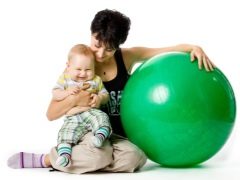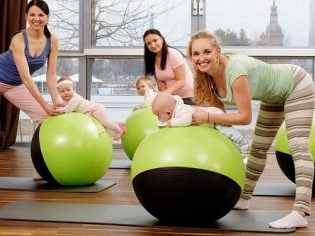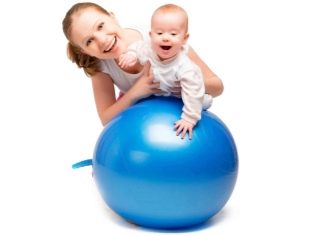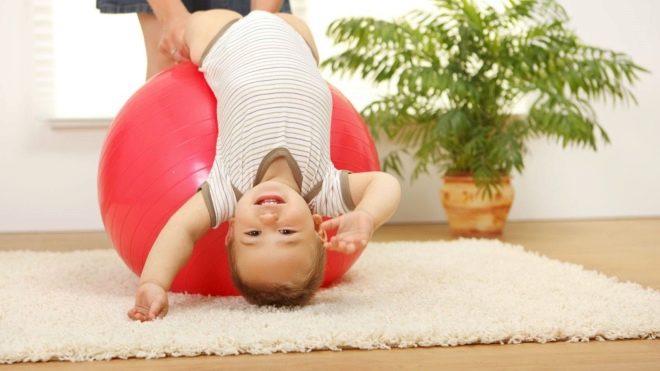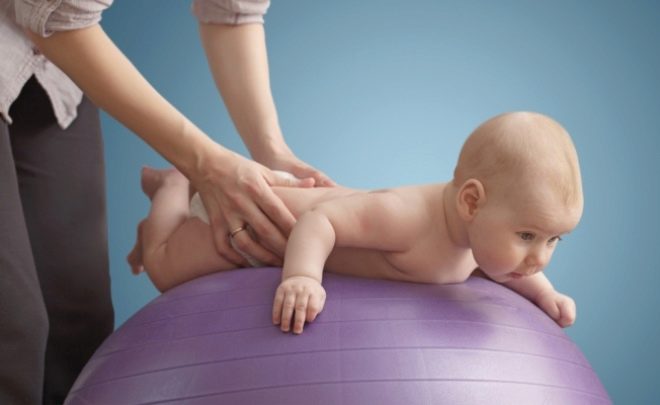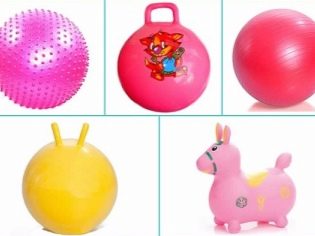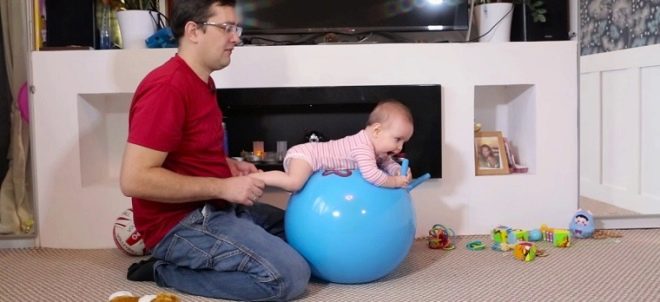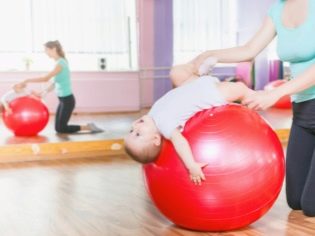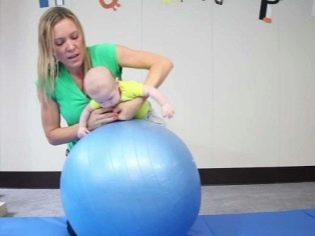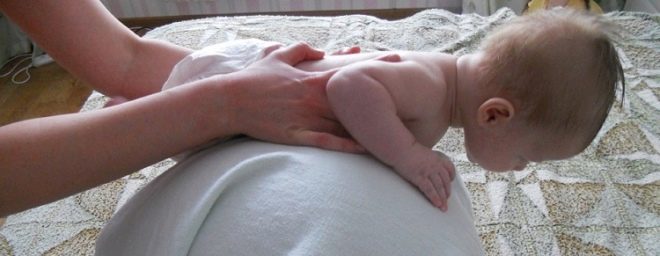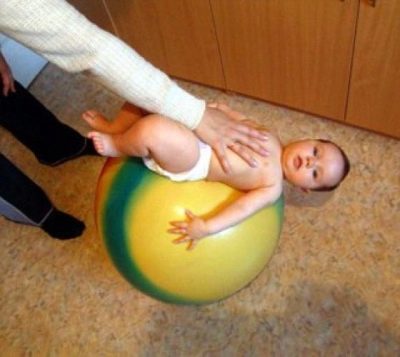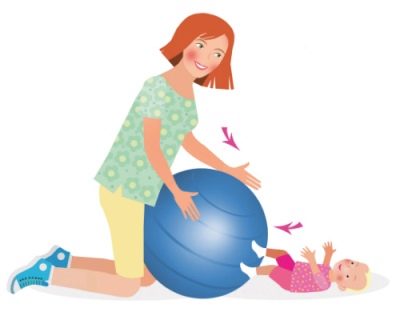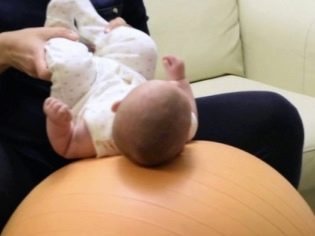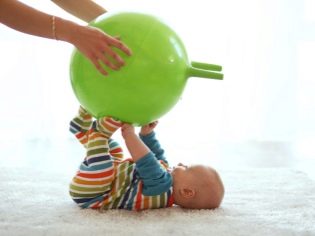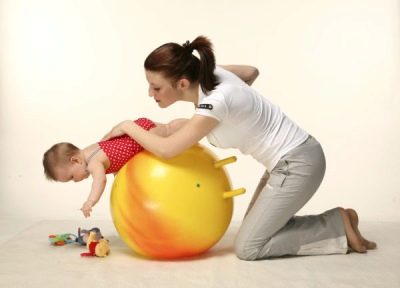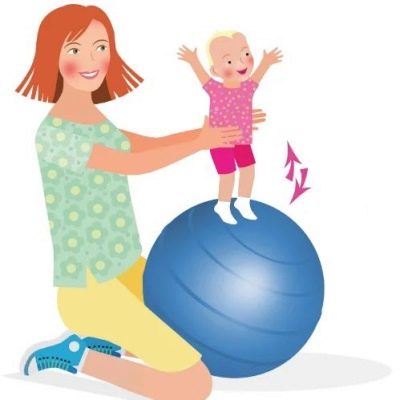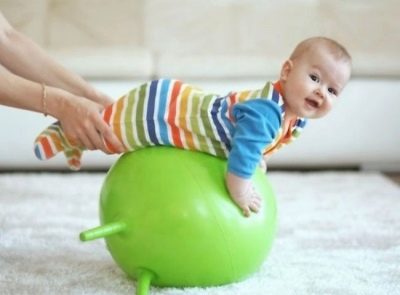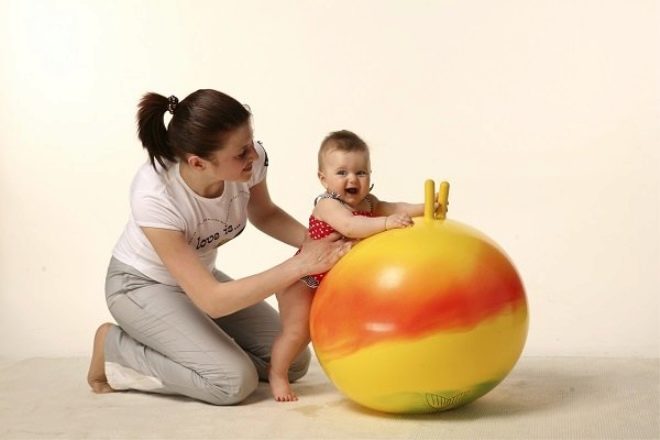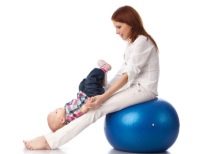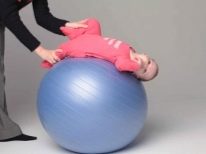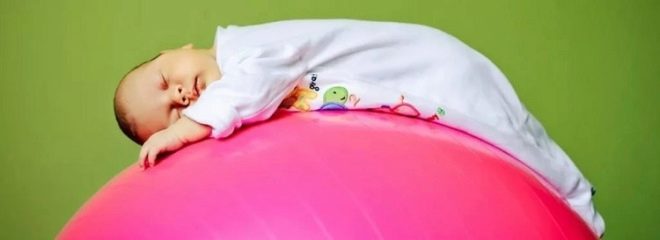Exercise on fitball for babies
Modern parents have much more opportunities for the physical and emotional development of their babies than their own parents many years ago. One of these popular and useful acquisitions is considered a gymnastic ball fitball. Classes are interesting and useful not only for children older than one and a half years, but also for newborn babies. In this article we will talk about how to organize exercises on fitball for babies, what exercises can be performed on the ball, depending on age.
Useful or harmful?
The question of the benefits and dangers of fitball for the development of infants does not have a definite answer. Most pediatricians are inclined to believe that harm is possible if parents do not follow the technique of performing gymnastics, if they too early begin to use a gymnastic ball for a peanut. The optimal age at which you can start such classes is the age of one and a half months. Until this age, it is better to refrain from various manipulations and exercises in order not to injure the spine and umbilical wound of the infant.
However, the benefits of training on the gym ball significantly outweigh the few disadvantages:
- helps to relieve the symptoms of muscle hypertonia, which are characteristic of almost every child from birth to 5-6 months;
- strengthened bone and muscular systems;
- the weak abdominal wall of the infant strengthens, which helps prevent or reduce the appearance of infant colic;
- the vestibular apparatus develops, the child better coordinates movements;
- the child is formed the correct statement of the feet, the correct posture;
- improves the condition of the nervous system.
In order for your baby to get the maximum amount of benefits from exercises on fitball, it is important to choose the ball itself.
For children aged 2-3 months, only smooth balls are suitable. At 4-5 months, it is quite possible to offer the baby for charging or gymnastics textured fitballs with pimples, ribs - this will be an additional massage effect.
The size of the ball also matters - if you buy it not only for a baby, but also for yourself, in order to quickly get into good physical shape after giving birth, take a bigger ball - 75 cm in diameter. If the ball is intended only for the crumbs, 45 or 55 cm in diameter will be enough.
Avoid fitballs of dubious quality that have a strong odor. Materials may be unsafe - a child may experience severe allergies, chemical burns. The surface of a good and high-quality fitball for infants is non-slip and even. Make sure you have ABS markings. - this means that the ball will not explode and will not burst at the time of use - the tests have been passed, which is what this marking actually says.
Do you already have a safety ball? Then we turn to the study of technology classes for kids under the age of one year.
General rules and recommendations
First of all, parents need to learn how to choose the right time to practice with a child - at the time of gymnastics, the baby should be slept, rested, healthy and well fed. However, it is not necessary to begin to perform a set of exercises immediately after eating, wait an hour and a half after feeding, and only then begin to practice.
Restorative exercises aimed at stimulating the muscles, toning the child, invigorating, it is better to do in the first half of the day, and it is optimal to perform a soothing relaxation complex of exercises in the evening, just before bathing and going to bed. If you do not take into account the orientation of the exercise complexes, you can disrupt the routine of the child’s day, worsen his sleep, with the result that classes will not benefit. The baby will not get enough sleep, he will feel tired.
It is necessary to increase the time of classes gradually - from 3-5 minutes to 15-20 minutes. The load should also increase wisely - start with one or two exercises, gradually introduce new tasks, increase the time for their implementation.
Securely hold the child during class so that he does not fall from the gymnastic ball and does not get injured. If a child desperately resists, shows signs of fatigue, is naughty, exercise should also be stopped - through tears and whims the benefits of gymnastics cannot be achieved, no matter how hard you try.
Always accompany the lesson with fun and relaxed comments, read poems, sing a song, this is important so that the child understands that he is not subjected to a strange ritual (which, by the way, can be dangerous!), He is played with. Only then will the baby begin to perceive the lessons adequately and positively.
If you practice with a naked baby, be sure to cover the surface of the fitball with a diaper - so it will be more pleasant for the baby. Do not forget about safety for a minute - do not leave the little one without support, support and attention - falling from a fitball can be very painful and traumatic.
Techniques for doing the lesson
With a baby from 1.5 to 3 months
This is the youngest age group involved in fitball. For such children, it is important to perform gymnastics in the most delicate gentle mode. Therefore, experts recommend groups of exercises aimed at relaxing muscles, reducing tone and preventing intestinal colic. The rest of the exercises while the baby is not needed.
Relaxing exercises on the gym ball for kids are very simple in execution.
- Riding on the belly. Put the baby on the fitball belly down, the head should also be turned on one cheek. Hold the child with one hand behind the back, the second for the legs. Start gently swinging the ball to the right and left side alternately. Gradually complicate the exercise by adding a swaying back and forth, and then - in a circle. Watch for speed and amplitude - the child should not be scared and rocked. This exercise facilitates the removal of intestinal gaziki, reduces the intensity and frequency of colic, strengthens the abdominal muscles.
- Riding on the back. Ride on the stomach, go to skating on the back. Put the child on the ball with the back, but so that the crumbs head does not fall back. Hold the baby's tummy with one hand, fix the legs with the other. To begin with, it will be quite easy to shake the baby from side to side, then the exercise is complicated in the same way as the first. Admission contributes to the formation of posture, the development of back muscles.
- Football for kids. The baby should be placed on the floor, on a special mat in position on the back. Fitball leaning against the legs and gently pushing the wall of the ball on the feet of the crumbs. Reflexively, the kid will push the ball away, thereby developing and strengthening the muscles of the legs. Increased tone due to intense, but soft extensor movements will decrease.
Avoid jumping exercises, riding the ball up and down. Do not sit on the baby fitball, it is still too early - the spine is not ready for a vertical load.
With a baby 4-6 months
At this age, you need to combine relaxation exercises with exercises for the development of a muscular corset. This will help your baby's favorite toys, he has already managed to get them. The complex of exercises becomes more meaningful and requires active participation from the kid.
- "Get a toy." This is a more complicated version of riding on the tummy, which was described in the complex for babies. Having rolled the baby, making circular movements on the stomach, put your favorite toy on the floor in front of football. The kid will reach for her, hold his legs tightly, fixing the back with the second hand. Stretching is important for the development of lateral oblique muscles, as well as to stimulate the abdominals and muscles and shoulder girdle. So that the efforts of the child are crowned with success, push the fitball a little away from you so that the little one can reach the toy and securely grip it with her hands.
"Jumping". Mom sits on the floor, clamps the fitball between her legs, fixing it. Supporting the child under the arms, she lifts and lowers his feet on the ball, it is important that the crumb pushed off the ball from the feet. It is better to start such an exercise from 5 months, and at the same time it is necessary to ensure that the load on the baby’s entire body does not fall on its feet.
- "Movable car". This is a variant of the “Wheelbarrow” exercise, loved by many children, in which the mother only holds the baby’s legs with her hands and he “walks” along the floor with her hands. The difference will be that the baby will handle the ball with handles, pushing it forward. Exercise well develops arms, chest, neck and upper back.
For children over 6 months
For babies of this age category, classes are even more complicated, and in addition to the above two complexes, they add exercises for the development of motor skills and dexterity.
- "Goalkeeper". If the child is sitting on his own, put him in front of you and push the ball towards him. The task of the child is to catch him with two hands, and ideally to push him back to his mother. Exercise develops coordination and logical abilities.
- "Horse racing". Plant the child, who has already begun to sit, on the ball and hold it by the sides closer to the armpits. First, slightly move the ball to the child's booty to the right and left, back and forth. This will warm up and prepare the muscles of the buttocks and back. Then perform a slack jump motion on fitball - exercise contributes to the development of the back muscles.
- "Snowball". This exercise is for babies who have started to stand on their own. It will help in the development of the first steps. Put the child at the ball, help grasp the ball “ears” by the arms. On the other hand, fix the ball with your foot so that it does not roll forward with great speed. When the crumb will hold tight, start gradually moving the ball forward, loosening the fixation with your foot. The child will gradually learn to step the legs behind the ball.
Useful tips
To make the product last as long as possible, Experts recommend using the following recommendations.
- Keep the fitball clean. Wipe it daily with a damp, clean cloth and wash it twice a week with baby soap.
- Do not proceed to perform more complex sets of exercises if the child has not yet reached the recommended age or has not mastered the exercises of the previous set.
- After class, remove the fitball where the baby does not see it. If a bright and interesting "thing" will appear once a day, it will be more entertaining than the usual, eye-appealing toy.
- To achieve more vivid results from homework with your baby, combine exercises and gymnastics on fitball with massage. You need to practice the ball after a massage, when muscle groups are warmed up and ready for additional load.
- Before practicing on fitball it is important to consult with a pediatrician in order to exclude contraindications to such manipulations from a child.
Contraindications
There are not very many contraindications for practicing on fitball, but it is necessary to get acquainted with them. It is better to refuse classes if the child has:
- high temperature, teething;
- recovery period after illness, severe weakness;
- diseases of the musculoskeletal system, paralysis and paresis (requires special therapeutic massage and exercise therapy complex);
- hydrocephalus;
- large umbilical or inguinal hernia (there is a risk of pinching);
- congenital heart defects (classes are possible, but only under the supervision of a physician);
- birth injuries (training is not excluded, but only after consultation and appointment of a complex with physiotherapy orthopedist).
Reviews
Many mothers note that children perceive fitball in their first classes without much enthusiasm. Some are afraid of him, there are some little kids who are afraid of a bright and huge object (and this is exactly what the Swiss ball looks like to a kid). To force a screaming child to lie down on the ball, which he fears, is impossible. This can cause serious disturbances in the functioning of the nervous system, in the psychological state of the child.
If the child does not want, force does not need to do anything. Experienced mothers advise to remove the ball away, out of sight, and get it in 2-3 weeks. If the reaction is the same, hide again and show the child after a couple of weeks. Almost all babies by half a year are no longer afraid of fitball.
Some mothers argue that the baby is very effective to rock on a fitball, even a newborn. To do this, the mother takes the crumb in her arms and sits on the ball. Rhythmic swaying acts as a soporific, if, of course, parents are not ardent opponents of motion sickness as such.
Many people note that the kid, who was accustomed from birth to gymnastics on fitball, grows stronger and less often ill. And the interest to the big ball does not disappear even after one and a half or two years, because even schoolchildren like to jump and sit on the Swiss ball.
In the next video you will find several useful exercises for a child on fitball.
